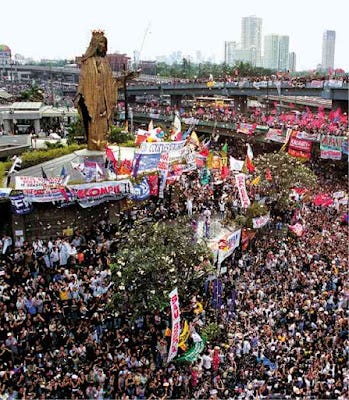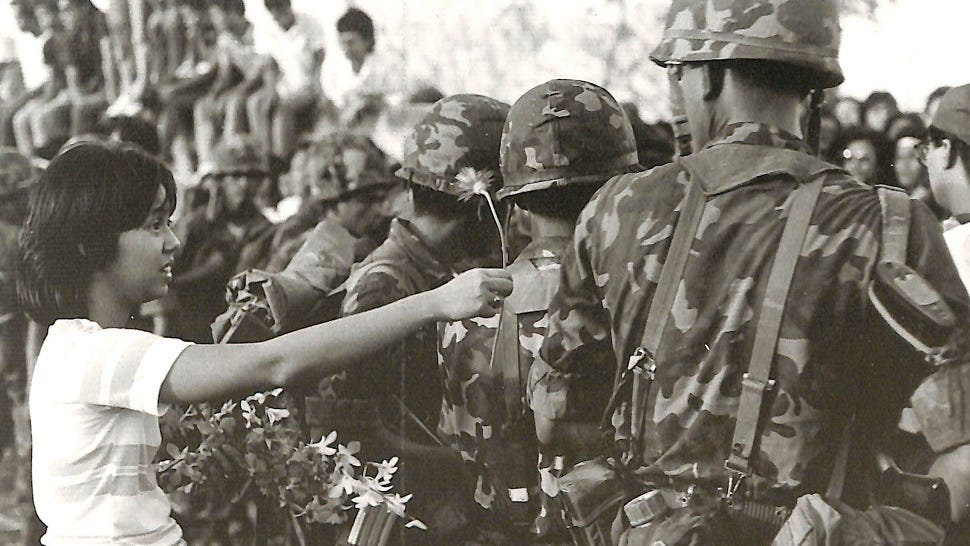(Author’s note: February 24 marks the Philippines' 39th anniversary of the People Power Revolution. Many Filipinos consider this event a watershed moment in the nation’s history, a source of pride and hope. Others have succumbed to cynicism and disillusionment, viewing it a “vanishing holiday,” an “erosion of collective memory,” or an” abandoned fading spirit.” I write this to recognize that the People Power Revolution of 1986 is unfinished business. Archibald MacLeish declared, “ (Democracy) is never a thing done. . is always something that a nation must be doing.” I also write this with a proud spirit: indeed, People Power in the Philippines did inspire numerous other peaceful uprisings around the globe: South Korea's Democratization Movement 1987; Myanmar's 8888 Uprising 1988; Tiananmen Square Protests 1989; the Velvet Revolution in Czechoslovakia 1989; the Singing Revolution in the Baltic States 1987-1991. No doubt, the People Power Revolution in the Philippines is a model for non-violent resistance in achieving political change).
When Cory Aquino left Boston in the late summer of 1983, shortly after the assassination of her husband, Benigno Aquino, she did not anticipate that her pristine and undisturbed life in a Massachusetts suburb would dramatically come to a close. Within days of her arrival in Manila, her ancestral home would be swamped with sympathizers, activists, politicians, and journalists from every corner of the world, wishing to view the slain body of her husband, still garbed in the same blood-stained clothes that he wore when he was assassinated upon arrival at the Manila International Airport on the morning of August 21, 1983.
Cory Aquino, the shy and reclusive widow of the most famous opposition politician to Ferdinand Marcos, emerged from the shadows of domesticity to become the icon of a reawakened national movement that would challenge the two-decade dictatorship of Ferdinand Marcos. From a political crusade that began in the streets as a cry for justice for her husband's brutal murder, Cory Aquino refashioned the political struggle into a presidential contest in which she ran as the opposition candidate to Ferdinand Marcos in a snap election in February 1986.
She was the perfect candidate to run against the dictator whom most Filipinos by then regarded as the cause of all the ills that plagued Philippine society. Marcos was the Darth Vader of Philippine politics, whereas Cory Aquino was Princess Leia Organa. She would rescue the country from further moral and political degradation by re-installing the democratic institutions that her rival Marcos had abolished when he declared martial law in 1972.
When the electoral results showed that Mrs. Aquino lost the elections, the citizens of Metro Manila rose in vigorous protest to challenge what many considered a fraudulent outcome.
On Saturday evening, February 22, 1985, people power began. And so did the longest, most colorful, most gregarious revolutionary picnic in all of global history --- a massive display of about a million peaceful protestors who trooped to Edsa to stop the tanks of Marcos with their flowers, rosaries, streamers, banners, music, and food.
It was political theatre at its best. Collective street jazz.
A camera caught a young girl offering a flower to a soldier; another zoomed in on a pilot who alighted from his helicopter and rushed to hug one of his military comrades after defecting to the side of the rebel forces. A phalanx of Catholic nuns clutched their rosaries as they stood in front of the soldiers who were sent to disperse them.
Source: People Power Revolution Photos - 10+ Best Photos from EDSA People Power Revolution
Source: Key players speak out 25 years on - UCA News
And then it was all over so very quickly. In the dead of night, the Marcos family gathered a handful of supporters and boarded two helicopters provided by the US government. They were flown to Clark Air Base. The following morning, US military planes flew them to Hawaii, where they would begin a long exile. The twenty-one-year dictatorial regime had collapsed, and the Philippines declared its first woman President.
Manila was declared a “liberated zone” a second time in forty years, this time from a local despot rather than a foreign invader (the Japanese).
The Political Ecology of EDSA
Epifanio de los Santos Avenue, commonly referred to as EDSA, is Manila’s gateway, a 26-kilometer stretch of asphalt and concrete that traverses the city’s eight municipalities. This main thoroughfare cuts across the upper—and middle-class enclaves and expatriate commercial and residential areas of San Juan and Pasig municipalities.
As a site for protest uprisings, Edsa would seem at first glance as a strange, if not a curious, venue on which to stage a revolt. Unlike China’s expansive Tiananmen Square or Argentina’s Plaza de Mayo, Edsa in 1986 was a rather narrow highway of six lanes divided by an island that organized, albeit unconvincingly, traffic flow in both directions. Instead of a vast quadrangle on which most collective action tends to take place, Edsa is a long, narrow asphalt worm traversing all the municipalities of metropolitan Manila, the host to thousands of vehicles that take urbanites across the city every day. This singular artery then can be conceived as a long, relatively straight filament whose tentacles branch close to it, where communities with their respective commercial amenities provide them with the comforts of urban life.
Sociologist William Sewell notes the vital role of spatial structures. He referred to the “strategic valence of space”—how space constraints are converted into a strategic resource. While structures are durable and constraining, they also provide an enabling effect that allows “humans to reproduce themselves and their social world . . . [and] also are subject to transformation as a consequence of the very social action that they shape”. Protestors create, produce, and renovate space to imbue fresh meanings and to transform the overall environment for protest.
From an avenue seemingly limiting large gatherings because of its architecture, protestors transformed EDSA into a roadway leading them to the shrine of political change. They converted a mundane avenue into a matrix of power. As the protestors took over EDSA, the notion of People Power was born, and the term entered Philippine political discourse for the first time. The avenue was power-charged. It was no longer a neutral, empty territory. With the achievement of a Durkheimian sense of “collective efflorescence,” EDSA was permanently transformed.
EDSA Shrine as Stage and Sentiment
In 1986, Cory Aquino was the quintessential animator of the protest theater, which was supported by a cast of millions—all determined to bring down the curtain on Marcos’s presidency. The stage décor was an avalanche of banners, streamers, and insignias wrapped in unmistakable yellow. It was a grand symphony of people surrounding themselves with protest colors—a sudden burst of expression against a repressive regime gone pale and colorless after 21 years of misrule.
The theatrical backstage fueled people power: a public address system to keep the protestors informed; a hookup to Radyo Bandido (Bandit Radio), which operated in secrecy from an undisclosed transmission tower after Marcos loyalists raided and destroyed Radio Veritas, the Catholic radio station; an endless supply of food and water for the rebel soldiers; portable toilets installed at strategic locations along the highway; and, of course, the rosaries and religious statues of the Virgin Mary with which protestors confronted Marcos’s army and weapons. Communication networks were mobilized via telephone and citizen-band radios. Taxi drivers spontaneously organized themselves to transport protestors to EDSA.
Shortly thereafter, the Edsa “shrine” was built as a living memorial to the 1986 People Power and has since become the site of any and all uprisings against perceived injustices. Its grandiose stage comes alive to the sound of agitators blaring into their bullhorns, chanting catchy protest slogans while working up the audience to a mixture of protest merriment and rage. In previous decades, People Power would be reenacted, and key actors would return to the shrine garbed in the clothes they wore during the protests, embellished by flab and wrinkles acquired with each passing year. After the reenactments, the stage is transformed into an entertainment platform with showbiz celebrities celebrating Marcos’s departure from the Philippines. The combination of pious, political, and leisure activities marked the popular uprising as an ecclesiastically approved political struggle-cum-all-night-revelry.
Nonetheless, EDSA is also a venerated public space, a repository of meanings collectively crafted and brought into fruition by shared sentiments, sanctified by the Church, and the rituals of adoration and blessing.
A central meaning of EDSA was the conquest of fear that governed life for decades of martial law and hindered the effective galvanizing of oppositional energies. Martial law enabled military forces accused of human rights violations to keep the population quiescent. The millions who gathered at EDSA to defy Marcos’s military machinery rediscovered their courage to end a long tyranny of silence.
The EDSA shrine is more than just a vessel that contains the historical memories of a nation in protest. In the words of the anthropologist Mircea Eliade, the shrine embodies an illud tempus, a time of origins, the period of Creation, and just after, when gods walked the earth, men visited the sky.
For Filipinos, EDSA is a gathering place to express a collective sentiment. It represents an era when it all began, a symbol of a political cosmology in which Filipino society was said to have genuinely emerged—not from the artificial demarcations created by the past maneuverings of competing colonial powers but from the singular action of millions of anonymous citizens who left the security of their homes to craft a nation in their image. For a country whose 500-year history was a series of colonial misadventures, political letdowns, and bungled attempts at nationhood, those four days at EDSA marked a grandiose departure from an overburdened past. For once in over five centuries, Filipinos experienced the nation as their own creation —a tangible possibility at self-determination, an expression of collective political agency, an imagined community, as the eminent political scientist Benedict Anderson called it, with which to display the result of their own handiwork to the world.
Postscript: A Reality Check
An unknown Buddhist monk wrote thousands of years ago: “After Enlightenment, it is time to wash the dishes.”
After Edsa, the nation faced the gargantuan task of rebuilding after a costly authoritarian experiment that set back the country for years.
Cory Aquino inherited a collapsed economy caused by excessive cronyism and outright misrule. She also inherited a centuries-old social structure beset by severe inequality, made worse by years of government neglect of the poor and marginalized.
In a country that sought a return to democracy, the precarious task of managing the democratic transition had to be undertaken. A constitution had to be written and ratified, elections had to be prepared, and public officials, whether appointive or elected, had to be retooled in democratic governance. These changes were accomplished in the thirty-nine years since EDSA and democratic governance was enshrined in political practice. But not without its flaws. Democracy in the Philippines remains in the stranglehold of family-based oligarchies — an “anarchy of families” as the political scientist Alfred W. McCoy aptly described Philippine politics.
The economy is beset by chronic poverty and inequality. There are perennial problems of unemployment and underemployment, as well as the question of investments, the equitable distribution of assets, and the creation of wealth that will enable the government to finance its programs for citizens’ welfare. Only a thoroughgoing structural change can deliver on these promises, regardless of the political system that claims to provide them best.
Thirty-nine years later, we are still learning the lessons of EDSA. A source of national pride, a moment of extraordinary hope, wrote Filipino sociologist Randy David. Many of us still share this sentiment.
But we also know about People Power as social critique, particularly the danger of equating the replacement of leaders without replacing social structures, mistaking the dramatic departure of presidents as equivalent to the accomplished task of social change. Considering this, EDSA remains far from finished.








Loved it. Amazingly well written. So evocative.